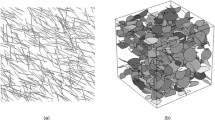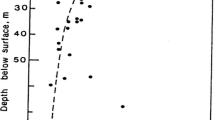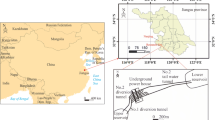Abstract
The hydraulic properties of a rough-walled fracture in a limestone sample are estimated using a network model based on three-dimensional representations of the fracture apertures. Two different scenarios are considered: drainage of water out of a fracture and infiltration of water into a fracture. Besides capillary effects, the model takes into account an accessibility criterion (invasion percolation) and, in the case of infiltration, the rate dependence of the water movement. A hysteresis effect between drainage and imbibition hydraulic properties can be observed, which increases with increasing capillary number. The measured permeability is overestimated by 15% by the network model. In a sensitivity analysis the influence of the main fracture field characteristics (field size and fracture segment size in relation to correlation length) on the calculated hydraulic properties is investigated. Field size has an important influence on the inverse of the water/air entry value α for imbibition, making it difficult to scale this parameter to other field sizes. A parameter analysis investigating the influence of the main fracture characteristics (mean fracture aperture, roughness, and correlation length) on the hydraulic properties shows that the mean fracture aperture is the most important fracture parameter influencing both strongly the saturated permeability K and α. The effect of varying the variance and the correlation length on K and α is much less than the influence of the mean fracture aperture. The effective permeability of the fracture is also calculated by the geometric mean K g . Up to σ(loge(K)) = 1, the discrepancy between K g and K n (network model result) is less than 15%. At larger correlation lengths (for a constant σ(loge(K))), the discrepancy between K g and K n increases.
Similar content being viewed by others
References
Abelin, H., Neretnieks, I., Tunbrant, S. and Moreno, L.: 1985, Final report of the migration in a single fracture: Experimental results and evaluation, Stripa Proj. Sven. Karnbransleforsorjing Tech. Rep. 85-03, Nucl. Fule Safety Proj. Stockholm, Sweden.
Bear, J.: 1993, Modeling flow and contaminant transport in fractured rock, in: J. Bear, C.-F. Tsang and G. de Marsily (eds), Flow and Contaminant Transport in Fractured Rock, pp. 1–37.
Blunt, M., King, M. J. and Scher, H.: 1992, Simulation and theory of two-phase flow in porous media, Phys. Rev. A 46(12), 7680–7699.
Blunt, M. J. and Scher, H.: 1995, Pore-level modeling of wetting, Phys. Rev. E 52(6), 6387–6403.
Chandler, R., Koplik, J., Lerman, K. and Willemsen, J. F.: 1982, Capillary displacement and percolation in porous media, J. Fluid Mech. 119, 249.
de Marsily, G.: 1986, Quantitative Hydrogeology, Academic Press, San Diego, California.
Fenwick, D. H. and Blunt, M. J.: 1998, Three-dimensional modeling of three phase imbibition and drainage, Adv. Water Resour. 21(2), 121–143.
Fourar, M., Bories, S., Lenormand, R. and Persoff, P.: 1993, Two-phase flow in smooth and rough fractures: Measurement and correlation by porous medium and pipe flow models, Water Resour. Res. 29(11), 3699–3708.
Gale, J. E.: 1977, A numerical field and laboratory study of flow in rocks with deformable fractures, Sci. Ser. 72, Inland Waters Dir.,Water Resour. Branch, Ottawa, Ont., Canada.
Glass, R. J., Nicholl, M. J. and Yarrington, L.: 1998, A modified invasion percolation model for low-capillary number immiscible displacements in horzontal rough-walled fractures: Influence of local in-plane curvature, Water Resour. Res. 34(12), 3215–3234.
Gutjahr, A. L., Gelhar, L. W., Bakr, A. A. and MacMillan, J. R.: 1978, Stochastic analysis of spatial variability in subsurface flows, 2. Evaluation and application, Water Resour. Res. 14(5), 953–959.
Gutjahr, A. L., Hatch, S. and Bullard, B.: 1995, Random field generation, Conditional simulation and flow modelling using the fast fourier transform, N.M. Inst. Of Min. and Technol., Socorro, NM, USA.
Hannant, D. J., Buckley, K. J. and Croft, J.: 1973, The effect of aggregate size on the use of the cylinder splitting test as a measure of tensile strength, Mater. Struct. 6(31), 15–21.
Klute, A. and Dirksen, C.: 1986, Hydraulic conductivity and diffusivity: Laboratory methods, in:Klute (ed.), Methods of Soil Analysis, Part 1. Physical and Mineralogical Methods, Agr. Monogr. no. (9), pp. 687–734.
Larson, R. G., Davis, H. T. and Scriven, L. E.: 1981, Displacement of residual nonwetting fluid from porous media, Chem. Engng Sci. 36, 75–85.
Lenormand, R. and Zarcone, C.: 1984, Society of Petroleum Engineers No. 13264, in: Proceedings of the 59th Ann. Tech. Conf. Of the SPE, Houston, TX (SPE, Richardson, TX).
Mendoza, C. A.: 1992, Capillary pressure and relative transmissivity relationships describing twophase flow through rough-walled fractures in geologic materials, PhD Thesis, Univ. of Waterloo, Ontasio, Canada.
Morrow, N. R.: 1975, The effects of surface roughness on contact angle with special reference to petroleum recovery, J. Can. Pet. Tech. 14, 42–53.
Mualem, Y.: 1976, A new model for predicting the hydraulic conductivity of unsaturated porous media, Water Resour. Res. 12, 513–522.
Murphy, J. R. and Thomson, N. R.: 1993, Two-phase flow in a variable aperture fracture, Water Resour. Res. 29(10), 3453–3476.
Neretnieks, I.: 1985, Transport in fractured rocks, in: Proceeding, Memoires of the 17th International Congress of International Association of Hydrologists, Vol. 17, International Association of Hydrologists, Tucson, Ariz, pp. 301–318.
Neuzil, C. E. and Tracy, J. V.: 1981, Flow through fractures, Water Resour. Res. 17(1), 191–199.
Nicholl, M. J., Rajaram, H., Glass, R. J. and Detwiler, R.: 1999, Saturated flow in a single fracture: Evaluation of the Reynolds equation in measured aperture fields, Water Resour. Res. 35(11), 3361–3373.
Piggot, A. R. and Elsworth, D.: 1993, Laboratory assessment of equivalent apertures of a rock fracture, Geophys. Res. Lett. 20, 1387–1390.
Pruess, K. and Tsang, Y. W.: 1990, On two-phase relative permeability and capillary pressure of rough-walled rock fractures, Water Resour. Res. 26(9), 1915–1926.
Pyrak, L. R., Meyer, L. R. and Cook, N. G. W.: 1985, Determination of fracture void geometry and contact area at different effective stress (abstract), Eos. Trans. AGU 66(46), 903.
Pyrak-Nolte, L. J.: 1991: Multiphase flow in fractures, in: Paper presented at the 1991 Coalbed Methane Symposium, Univ. of Ala., Tuscaloosa, Ala., May 13-16.
Snow, D. T.: 1968, Rock fracture spacings, openings, and porosities, J. Soil Mech. Found. Div. Amer. Soc. Civ. Eng. 94(SM1), 73–91.
Tokunaga, T. K. and Wan, J.: 1997, Water film flow along fracture surfaces of porous rock, Water Resour. Res. 33(6), 1287–1295.
Tompkins, J. A., Gan, K. C., Wheater, H. S. and Hirano, F.: 1994, Prediction of solute dispersion in heterogeneous porous media: Effects of ergodicity and hydraulic conductivity discretisation, J. Hydrol. 159, 105–123.
Vanderborght, J.: 1997, Experimental and numerical study on non-reactive solute transport in soils, PhD Thesis, KULeuven.
Vandersteen, K., Busselen, B., Van Den Abeele, K. and Carmeliet, J.: 2002, Quantitative characterization of fracture apertures using microfocus computed tomography, in: Proceedings of the Geological Society of London (accepted).
van Genuchten, M. Th.: 1980, A closed form equation for the prediction of hydraulic properties of unsaturated soils, Soil Sci. Soc. Am. J. 44, 892–898.
Wilkinson, D. and Willemsen, J. F.: 1983, Invasion percolation: a new form of percolation theory, J. Phys. A: Math. Gen. 16, 3365–3376.
Yeo, I. W., Zimmerman, R. W. and de Freitas, M. H.: 1998, Effect of shear displacement on the aperture and permeability of a rock fracture, Int. J. Rock Mech. Min. Sci. 35, 1051–1070.
Zhou, D., Blunt, M. and Orr Jr., F. M.: 1997, Hydrocarbon drainage along corners of noncircular capillaries,J. Coll. Interf. Sci. 187, 11–21.
Zimmerman, R.W. and Bodvarsson, G. S.: 1996, Hydraulic conductivity of rock fractures, Transport in Porous Media 23, 1–30.
Author information
Authors and Affiliations
Rights and permissions
About this article
Cite this article
Vandersteen, K., Carmeliet, J. & Feyen, J. A Network Modeling Approach to Derive Unsaturated Hydraulic Properties of a Rough-Walled Fracture. Transport in Porous Media 50, 197–221 (2003). https://doi.org/10.1023/A:1021150732466
Issue Date:
DOI: https://doi.org/10.1023/A:1021150732466




